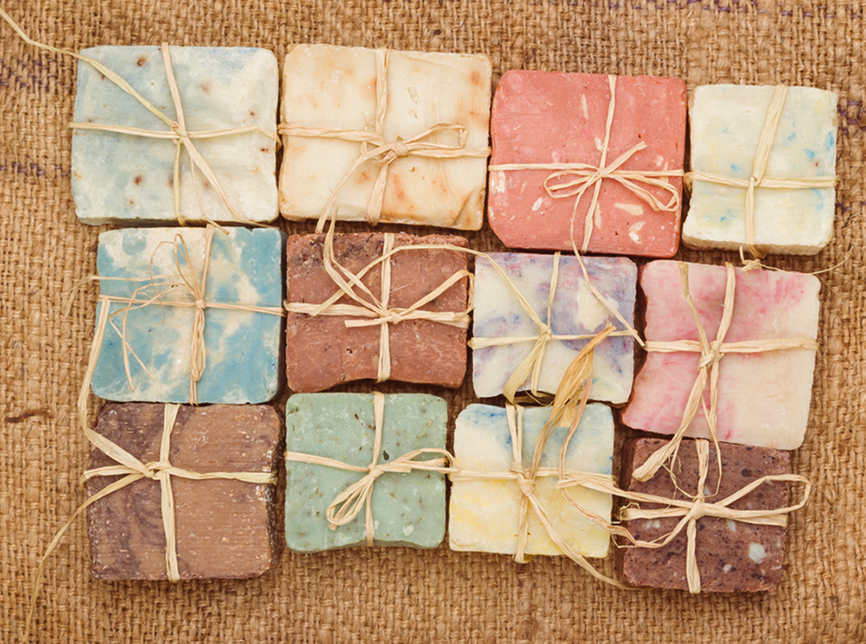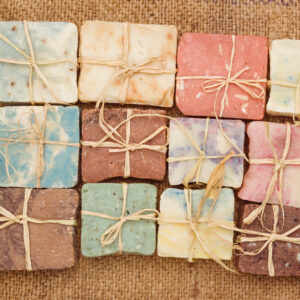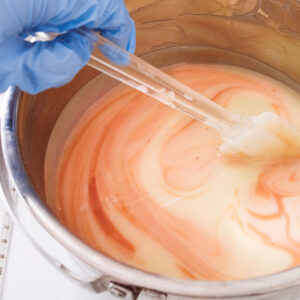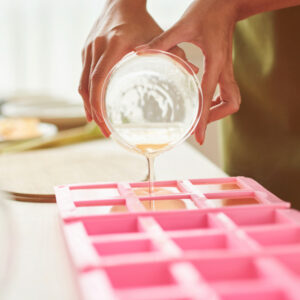Homemade Soap (with Leaf Lard!)

For hundreds of years, soap has been made out of animal fats in many parts of the world, often from household drippings. It’s only recently we’ve become a bit funny about using animal fats for anything. For this reason, lard can be a controversial ingredient in soap making. Some are concerned that animal fat will make their soap greasy and clog pores. Actually, it is quite the contrary. Lard resembles the structure of human skin cells which is composed of saturated fats. Lard soap is closer to our skin than plant-based soaps. Source: https://www.frugalandthriving.com.au/homemade-lard-soap/
See the original article and step-by-step instructions on https://www.frugalandthriving.com.au/homemade-lard-soap/ by Melissa Goodwin

I know this isn’t a popular stance, but I can’t see the point of using expensive food oils in soap, like coconut oil, which puts a lot of extra strain on the environment, when animal fats are more often than not thrown away after we eat only the choice cuts of meat. Lard makes a very mild, conditioning soap that is great for your skin. Unlike commercial soaps, where the glycerin is removed and sold as a separate by-product, homemade soap retains the glycerine, which is very moisturizing.
Lard doesn’t lather very well, though, so if you’re expecting a bubbly lather from your soap, it’s a good idea to add another oil, like a little bit of castor oil (about 5%). Lard on its own makes a great laundry soap for homemade laundry detergent, although we use ours for personal washing and it cleans just fine. It’s a very luxurious soap.
This article will walk you through step-by-step how to make lard soap.
Making Old-Fashioned Lard Soap
Soap Making Precautions
Let’s get the scary but important stuff out of the way first.
Soap is made from lye (otherwise known as caustic soda or soda ash) which is extremely alkaline. When mixed with water, it causes a chemical reaction that gives off fumes and will burn your skin on contact.
So due care must be taken when mixing the lye and water and making the soap.
Always add the lye to the water not the water to the lye, or you might get a volcanic eruption happening.
Wearing gloves and protective glasses is advisable. If you do happen to accidentally get some on your skin, keep some vinegar close at hand to help neutralize the burn.
When the lye and water mix, there is a chemical reaction, and they give off fumes, so it’s best to mix them in a well-ventilated area or outside.
And make soap when the kids and the pets are not around.
Lard Soap Ingredients
- Rendered lard (see measurements below)
- Water (distilled, filtered or rainwater is best)
- Pure caustic soda/lye (with no other ingredients)
Lard Soap Making Equipment
- Accurate kitchen scales
- A large pot (not aluminum)
- A Pyrex jug or smaller pot
- A wooden spoon just for soap making
- Kitchen thermometer
- A stick blender (optional, but will save you a lot of stirring)
- A spatula
- A mound (see notes above)
- Rubber gloves and safety glasses
- White vinegar (for spills)
The Soap Making Process
 Soap can be made by using either the cold or hot process. Today, I’m sharing how to make cold processed soap, which is quicker and easier.
Soap can be made by using either the cold or hot process. Today, I’m sharing how to make cold processed soap, which is quicker and easier.
There’s very little difference between the two processes except that the soap is cooked after you combine the fat and lye in the hot process, whereas in the cold process, the fat is heated initially, but then there is no further cooking.
Weighing and calculating your soap recipe
All ingredients, including your water, must be weighed accurately. I have an old-fashioned set of scales with a dial, but if you’ve got digital scales, all the better.
Place your pot on the scales and tare your scales (set them to zero). Then add your lard and weigh it.
Now enter the amount of lard you have into an online soap calculator (like this one or this one or this one) to work out how much water and lye you will need.
Whenever you read a soap recipe, you should always run it through a soap calculator or two to double check.
Once you have a soap recipe you like, you can write it down and use it again and again. If you’re not sure how much lard you’ll have after rendering, start by weighing what you’ve got each time and calculating the recipe from there.
[A note on superfatting (you will see this in the soap calculators): Superfatting is a term that means adding more fat or oils to your soap than the lye can react to. Superfatting makes your soap more moisturizing. It also acts as insurance that there’s enough oil to react with the lye so there’s no lye leftover, which can burn if there is.
I superfatted my soap at 5%, just to be on the safe side. Superfatted soap isn’t great soap for the laundry, so if you’re making laundry soap, you want to superfat as little as possible. If you don’t superfat your soap, just be careful when unmolding it (wear your glasses and gloves) and look for any spots of lye that have not reacted with the oils.]
Now place a jug on the scales and tare them again, and weigh your water according to the recipe the soap calculator works out for you.
Then in a separate container, weigh out the lye.

Making your lard soap
- Prepare your soap mold(s) by greasing them with a little lard. You can also line them with baking paper if desired.
- Using an accurate set of scales, place your pot on the scales and reset them to zero. Add the lard and weigh it.
- Using an online calculator (i.e. calculator one, calculator two, calculator three) enter how much your lard weighs to calculate how much water and caustic soda/lye you will need.
- Write down your soap recipe according to the calculator.
- Remove the pot from the scales and place your jug on them. Reset the scales to zero. Weigh your water according to the soap recipe from the soap calculator.
- Remove jug. Place a third container on the scales and reset them to zero. Weigh your caustic soda according to the recipe from the soap calculator.
- Melt the lard in a pot on the stove until it reaches between 37°C and 51°C.
- In a well ventilated area, add the weighed caustic soda/lye to the water, stirring as you add it.
- Let the lye mixture cool until it too reaches between 37°C and 51°C.
- Once both the lye mixture and the lard are at the same temperature, pour the lye mixture into the melted lard. Stir as you pour making sure not to splash.
- Stir to combine and then use your stick mixer to mix the soap until it comes to trace.
- Once soap has come to trace, pour into your prepared mold.
- Wrap mound in a towel and place somewhere safe for two or three days for the soap to set.
- Once your soap has gone hard, turn it out of the mold and cut into bars.
- Leave to cure in a cool dark place for a few weeks to cure and go hard. Turn bars every few days to dry evenly.
For detailed instructions and additional notes, please visit https://www.frugalandthriving.com.au/homemade-lard-soap/
